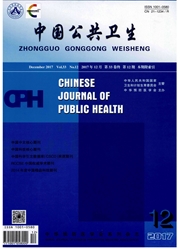

 中文摘要:
中文摘要:
目的探讨体质指数(BMI)与腰臀比(wHR)对蒙古族高血压交互作用的影响。方法采用对数线性模型方法对2589名蒙古族人BMI、WHR数据进行分析。结果体质指数(BMI)〈24、24~和28~各组高血压患病率分别为32.10%,47.42%和64.57%。腰臀比(WHR)〈0.8、0.8~和0.9~各组高血压患病率分别为21.19%。32.90%和54.02%。蒙古族人群的BMI和WHR均与高血压关联密切(P〈0.001);性别、BMI、WHR均独立作用于高血压,BMI和WHR之间的交互效应与高血压无关联。结论BMI和WHR是蒙古族高血压的独立危险因素。
 英文摘要:
英文摘要:
Objective To explore the influence of the interaction of BMI and WHR on hypertension in Mongolian people. Methods The data of BMI, WHR and hypertension from 2589 Mongolian people were analyzed by log - linear model analysis method. Results Hypertension prevalence rates were 32.1%, 47.42 % and 64.57 % for participants with BMI of less than 24, 24 - 27, and more than 28, respectively. Hypertension prevalence rates were 21.19 %, 32.90 96 and 54.02 % for participants with WHR less than 0.80, 0.80 - 0.89, and more than 0.90, respectively. Gender, BMI, WHR were independently associated with hypertension(P 〈0. 001). There was no significant association between the interaction of BMI with WHR and hypertension(P 〉 0.05). Conclusion BMI and WHR are independent risk factors of hypertension in Mongolian people, and log - linear model analysis method is an ideal method in analyzing the interaction of poly - dimensional contingency tables.
 同期刊论文项目
同期刊论文项目
 同项目期刊论文
同项目期刊论文
 期刊信息
期刊信息
